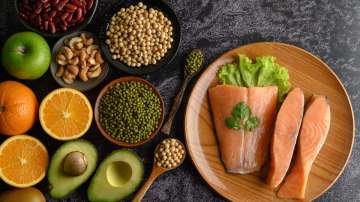7 iron-rich foods to eat to increase haemoglobin count
Discover optimal health with these 7 iron-rich foods. From spinach to lentils, add these food items to your diet to boost your haemoglobin levels and combat iron deficiency for overall well-being.

Haemoglobin, a protein rich in iron, plays a crucial role in transporting oxygen throughout the body. When haemoglobin concentrations dip below the standard range, individuals may experience symptoms such as fatigue, weakness, and headaches. If the levels drop significantly, a diagnosis of anaemia may be warranted. As outlined by the World Health Organization (WHO), anaemia is a condition resulting from lower-than-normal haemoglobin levels in red blood cells.
According to the latest National Family Health Survey (NFHS) 2019-21 report conducted by the Ministry of Health and Family Welfare (MoHFW), there has been a significant increase in the prevalence of anaemia in India. The findings reveal a worrisome scenario, with 57% of women aged 15-49 and 67% of children aged six months to 59 months identified as anaemic. This marks a notable rise from the figures reported in NFHS-4 (2015-16), which recorded anaemia rates at 53% for women and 58.6% for children.
What are normal haemoglobin levels?
Children: 11 to 13 gm/dL
Adult males: 14 to 18 gm/dL
Adult women: 12 to 16 gm/dL
Men after middle age: 12.4 to 14.9 gm/dL
Women after middle age: 11.7 to 13.8 gm/dL
Thus, boosting haemoglobin levels is crucial for overall health, and incorporating iron-rich foods into your diet can make a significant difference. Here are seven food items that can help enhance your haemoglobin.
Beetroots: Known for their high iron content, beetroots are essential for red blood cell production. The presence of vitamin C and folate in beets further enhances iron absorption, promoting a healthy increase in haemoglobin and supporting overall blood health.
Legumes: Peas, lentils, beans, and soybeans are excellent sources of iron. Including legumes in your diet contributes to increased iron intake, aiding in haemoglobin production and preventing anaemia. Legumes are particularly valuable for those who prefer non-meat alternatives.
Meat: Especially red meat, is a rich source of heme iron, which the body absorbs more efficiently than non-heme iron from plant sources. Heme iron plays a crucial role in haemoglobin production, helping prevent and treat anaemia by elevating iron levels and improving overall haemoglobin concentrations.
Nuts and Dried Fruits: Dates, walnuts, almonds, dried apricots, and raisins are rich sources of iron. While providing essential iron, nuts contribute to immune system strength. It's worth noting that dates, though high in iron, may not be suitable for diabetic individuals due to their sugar content.
Seeds: Pumpkin, sesame, hemp, and flax seeds are iron-rich and contain folic acid and vitamins that support haemoglobin production. Regular consumption helps prevent iron deficiency, promoting blood health and naturally increasing overall haemoglobin levels.
Fruits: Pomegranates, watermelons, grapes, and apples are iron-rich fruits that contribute to maintaining a healthy haemoglobin count. These fruits can be easily incorporated into salads, cereal, oatmeal, smoothies, or juices.
Spinach: Green leafy vegetables like spinach, broccoli, and mustard greens are ideal for those following a plant-based diet. In addition to their high iron content, these vegetables provide natural sources of vitamin B12, folic acid, and other essential nutrients, supporting haemoglobin production and overall health. Making green vegetables a staple in your diet is a beneficial choice for everyone.
ALSO READ: Unhealthy gut symptoms: Recognise THESE 5 symptoms for deteriorating gut health